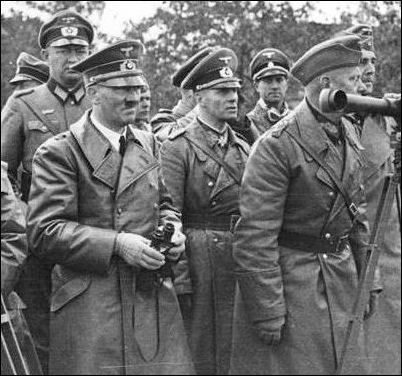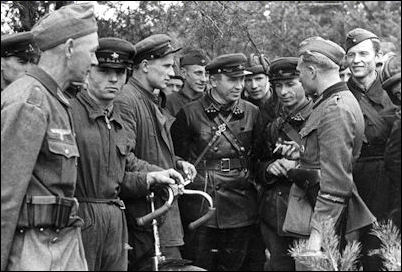![]()

Poland is Crushed
At dawn on Friday morning, September 1, 1939, two decades of pent-up military frustration among the German officer corps was unleashed by Adolf Hitler as a million-and-a-half German soldiers roared into Poland via several gigantic mechanized formations, smashing all opposition in sight. It was first time the world had ever witnessed Blitzkrieg (lightning warfare) involving carefully coordinated attacks of planes, tanks, motorized troops and self-propelled artillery, all set to a precise timetable.
The outgunned Polish Army, consisting of 35 divisions, and totaling just half-a-million soldiers, put up a brave but futile resistance against this mechanized onslaught. The revolutionary German tactic was to pinpoint one small spot on the front line, attack it with overwhelming force, then send a flood of tanks, armored troops and motorized infantry through that narrow opening. The motorized infantry then split into two formations, circled around and surrounded the confused enemy. Meanwhile, the main armored thrust continued forward, rolling through the countryside at speeds up to 40 miles-per-hour while heading toward the main goal, Poland's major cities.
Along with this, the German Luftwaffe (Air Force) conducted terror-bombings of the cities, to create civilian panic, chaos and confusion, which softened up the intended targets prior to ground attack. Worse for the Poles, the Luftwaffe methodically attacked Polish airfields, destroying nearly 500 sitting warplanes during the onset of the invasion, further weakening the Polish defense.
Overall, Blitzkrieg worked better than anyone in the German High Command or Hitler himself had anticipated. In a few days, the hopelessly outgunned Polish Army teetered on the verge of collapse. By September 6th, Cracow, Poland’s second most important city had fallen.
Polish officials then hurried off to exile, signaling the collapse of the Polish government and the effective end of national resistance as the Germans overtook the scattered remnants of the Polish Army.
Only at Warsaw, the country’s capital, did Polish troops continue to hold out, inspired by the city's radio station which played the Polish national anthem non-stop around the clock. The Germans responded with massive artillery and aerial bombardments, personally witnessed by Hitler who came to the front to watch. Amid mounting civilian casualties and with the historic city nearly reduced to rubble, Polish troops in Warsaw finally surrendered.
It had taken Hitler's incredible war machine just 18 days to conquer Poland.
Now it was time for Soviet dictator Josef Stalin and the Russians to get in on the action. In late August 1939, just before invading Poland, Hitler had forged the Nazi-Soviet Pact with Stalin. The political agreement contained secret clauses promising Stalin about half of Poland, along with Latvia and Estonia, two adjoining countries once a part of Russia.
Upon the German invasion of Poland, the Russians were supposed to strike from the east and grab their share. But Poland's speedy demise caught Stalin off guard and the Russians were unprepared. Under pressure from Hitler's diplomats, Stalin sped things up and sent Russian troops to invade the now-defenseless country beginning on September 17th, grabbing the eastern half of Poland which included territories home to various Russian speaking communities.
Stalin, a calculating and ruthless opportunist like Hitler, now sensed the chance to grab even more. He pressured the Germans into letting him take Lithuania in addition to Latvia and Estonia. As a trade-off, he offered the Germans a portion of his Polish territory east of the Vistula River, which included the entire Warsaw Province.
Hitler accepted the deal without argument. Right now, with other things to worry about, he needed to placate Stalin and keep the Pact going. Thus the two dictators traded whole populations. When all of the bargaining was done, the Germans were left with the bulk of western Poland, home to millions of ethnic Poles, a Slavic people whom the Nazis contemptuously regarded as Untermenschen (sub-humans).
To break the pride and spirit of the Poles, five SS execution squads called Einsatzgruppen entered German-occupied Poland. Under the command of Reinhard Heydrich, they rounded up and shot thousands of Polish civic leaders, intellectuals, clergy and anyone else who might oppose Nazi rule. Additionally, over a million Poles were abruptly expelled from their homes and farms to make way for ethnic Germans. As winter approached, many of the homeless Poles would die from hunger and exposure to the elements.
In Poland, the pattern of Nazi behavior in conquered territories was first established. Advancing German Army troops would be followed by SS units and Nazi administrators who would coordinate their efforts to subjugate, exploit, resettle, and even murder the native population.
For Adolf Hitler, his very first military victory had come easily, just like the string of easy diplomatic victories dating back to 1936. But the specter of Europe's last war still loomed large in his mind. When he gave the order to invade Poland, Hitler really didn't know how Britain and France, the enemies of World War I, who had sacrificed millions of lives to stop German aggression back then, would react to Nazi military aggression now. But he would soon find out.
Copyright © 2010 The History Place™ All Rights Reserved
![]()
NEXT SECTION - A New World War
The Defeat of Hitler Index
The History Place Main Index Page
Terms of use: Private home/school non-commercial, non-Internet re-usage only is allowed of any text, graphics, photos, audio clips, other electronic files or materials from The History Place.

